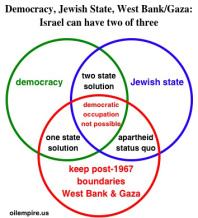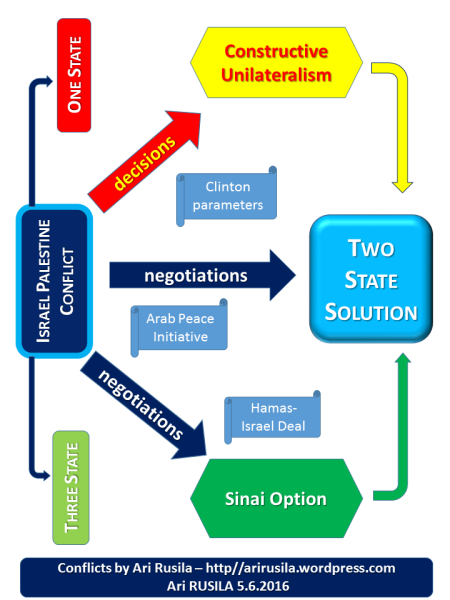 The Israel leftist movement has been in decline some four decades and especially since 2001. BESA center has recently publishe two pespective papers (by Gershon Hacohen in BESA and by Shmuel Sandler in BESA)which try to describe reasons for this decline.
The Israel leftist movement has been in decline some four decades and especially since 2001. BESA center has recently publishe two pespective papers (by Gershon Hacohen in BESA and by Shmuel Sandler in BESA)which try to describe reasons for this decline.
Maj. Gen. (res.) Gershon Hacohen claims that spatial separation between Israelis and Palestinians – “they are there and we are here.” – as the main position of Left has been disastrous. Prof. Shmuel Sandler (emeritus) claims that the two-state framework has long been the preferred international, as well Labor party, solution to the Palestinian-Israeli conflict, however, opting for that solution have been punished at the polls.
Zionist Left
The Israeli Labor Party is a social democratic and Zionist political party in Israel. It was was established in 1968 by a merger of leftist Mapai, Ahdut HaAvoda and Rafi parties. Since Israel independence 1948 all Israeli Prime Ministers were affiliated with the Labor movement and during the 1970s, the welfare state was expanded under successive Labor governments; but, despite its achievements, in the 1977 elections, Labor for the first time ended up in opposition.
In 1977-96, Labor was headed by two leaders: Shimon Peres and Yitzhak Rabin. Labor won two elections during that period: in 1984 and in 1992. In none of the elections from 1977 through 1992 did Labor accept the PLO leadership as a partner in a peace process between the Jewish state and the Arab states; in stead the perceived partner was the Hashemite Kingdom of Jordan. Future borders between Israel and its eastern partner were drawn according to the Allon Plan, which envisioned Israeli control over the Jordan Valley and strategic territories scarcely inhabited by Palestinians. The position of Labor changed after Oslo accords and Labor accepted the concept of a Palestinian state and Ramallah replaced Amman as the future partner.
Especially since 2001 the Israel leftist movement has been in decline, at least in elections. Following the October 2000 riots and the violence of the al-Aqsa Intifada, Ehud Barak (PM/Labor) resigned from office. He then lost a special election for Prime Minister to Likud’s Ariel Sharon. However, Labor remained in Sharon’s coalition as he formed a national unity government with Likud, Labor, Shas, Yisrael BaAliyah and United Torah Judaism, and were given two of the most important cabinet portfolios; Peres was appointed Minister of Foreign Affairs and Benjamin Ben-Eliezer was made Defense Minister. Labor supported Operation Defensive Shield, which was conducted in April 2002 against Palestinians in the West Bank. After harsh criticism that Peres and Ben-Elizer were “puppets” of Sharon and not promoting the peace process, Labor quit the government in 2003.
Prior to the 2003 elections, Amram Mitzna won the party primaries, and led the party into the election with a platform that included unilateral withdrawal from the Gaza Strip. The party was routed in the elections, winning only 19 seats (its lowest ever), whilst Sharon’s Likud won 38 (40 after Yisrael BaAliyah merged into the party). Subsequently, due to internal opposition, Mitzna resigned from the party leadership, and soon afterwards was replaced by Shimon Peres. Despite being omitted from the original right-wing coalition, Sharon invited Labor into the coalition to shore up support for the disengagement plan.

Spatial separation
Maj. Gen. (res.) Gershon Hacohen claims that ever since Israel’s withdrawal from Lebanon in May 2000, it has been axiomatic among Israeli decision-makers that spatial separation between Israelis and Palestinians is a vital Israeli interest, even if not accompanied by a peace agreement. In line with this thinking, Israelis have been repeatedly promised that the implementation of spatial separation, including the removal of Jews from these territories and the construction of a security fence, would reduce daily friction and create a safer and more stable security situation.
Mr Hacohen asks where a more workable security situation has developed Is it in Gaza after the unilateral disengagement thirteen years ago where complete separation has been effected, or in the West Bank, where Prime Minister Yitzhak Rabin’s vision of partial separation prevails?
Mr Hacohen claims that since Operation Defensive Shield in 2002, the Israeli security forces have been conducting regular counterterrorism activities throughout the West Bank as a matter of course. Generally authorized by the Central Command and the Shin Bet without the need for the approval of the political echelons, this routine activity has given the security forces freedom of action and operational flexibility, which, together with other factors, has ensured relative calm and stability in the West Bank. However in stark contrast, the total spatial separation between Gaza and Israel as of the summer 2005 disengagement has denied the IDF freedom of action beyond the border fence. Not that the IDF’s overall capabilities have been reduced, but by transforming the Strip into an ineradicable terror entity that can exact a heavy price from invading Israeli forces, Hamas has succeeded in placing a strategic “price tag” on a wide range of activities short of overall confrontation. It is no secret that the balance of costs, risks, and opportunities that accompanies the decision to act in Gaza has become infinitely more complex since the disengagement.

No separation = One-State solution
I addition the border fence enables Hamas to grow stronger and to organize safely under its protective wing. Hamas has managed to build a regular military force comprising battalions and brigades, armed with a large below-ground rocket/missile arsenal and supported by an effective command and control system. None of this would be possible without the full realization of the Israeli leftwing concept of “they are there and we are here.”
Two-state framework as cause of Israel’s Zionist Left Decline
The low standings of the Zionist Camp list, formed before the last elections in 2014 by Labor, headed by Yitzhak Herzog, and the Movement party, headed by former foreign minister Tzipi Livni, floated a new demand for change at the top. According Shmuel Sandler the Labor party is thus once again challenging its newly elected chairman, Avi Gabai. But if Labor leaders want their party to become a real contender for the office of Prime Minister and an alternative to Likud rule, they should replace their partner for a durable solution to the Arab-Israeli conflict rather than replace their own leaders.
Labor has replaced eight chairpersons in the past twenty years. According Shmuel Sandler the leadership of Labor refuses to recognize is that its main problem is not who leads the party but its identification with the failed Oslo process, which installed the PLO leadership in Ramallah and Gaza (before its loss to Hamas in 2007). A short analysis of the 40 years since Labor’s defeat in 1977 after having ruled Israel since its inception – a turning point in Israel’s political history – shows that the problem is not one of leadership but of political identity. Because it is identified with Ramallah’s behavior and demands in any future settlement, Labor has suffered repeated electoral punishment.
New Leftist approach
Throughout two decades of the Israeli-Palestinian “peace process,” direct negotiation has been perceived as the only paradigm that can lead to an agreement “Two-State solution as its final aim. The failure to reach an agreement has given excuses to the rejectionists and extremists on both sides, allowing them to blame the other party for failure to progress, and destroying the belief within the respective societies that an agreement is possible in the foreseeable future.
Israel’s Left as well sc international community and Arab League have supported Two-Sate solution The final status agreement has been very close at least since Beilin-Abu Mazen understandings/agreement/plan (1995) where nearly all issues were agreed. The Olmert proposal (2008) was probably the last serious try. (both plans can be found from my document library ) The parameters of the end-game have been clear the whole time but despite of a number of negotiations the final agreement is missing.

One provocative view to issue
Both analysts – Hacohen and Sandler – claim that Two-State and spatial separation between Israelis and Palestinians as the main position of Left are the causes of Israel’s Zionist Left decline. My conclusion differs from theirs. From my point of view the new Leftist approach has wide support in Israeli political map besides in Center-Left also in Center and Center Right which support makes its implementing realistic in future. In addition already partly implemented spatial separation with help of security barrier has decreased dramatically suicide bombings from West Bank. Sure behind the border Hamas can build more easily its military capabilities than in West Bank as Hacohen says but as seen during “Great Return March” campaign from April 2018 the IDF (Israel Army) has effective countermeasures and civilians mostly could continue their civilian routines. In West Bank situation is worse as the security barrier and spatial separation are not so ready than with Gaza.
I agree with Sandler that the political identity of Israel’s Left is has been connected with Two-State solution, however not anymore identified with Ramallah’s behavior, as Sandler claims, nor with traditional roadmap of peace process. It is clear that to solve Israel-Palestine conflict a new approach to the peace process is needed; and recently Israel’s Left has done exactly that.
Spatial separation and constructive unilateralism
Already 2012 then Defense Minister Ehud Barak, leader of the Labor Party until January 2011, said that Israel should consider imposing the borders of a future Palestinian state, becoming the most senior government official to suggest bypassing a stagnant peace process.
Leader of the Israeli opposition – and Labor/Zionist Union – Isaac Herzog has proposed to divide the land between the Israelis and Palestinians. Following a quote from interview of Isaac Herzog in Fathom :
I speak in a very frank and open manner. I believe that Israel must move for peace. We must move towards the division of the land between the Palestinians and us in order to maintain the future of Israel as a Jewish democratic state… If we reach an agreement to separate from the Palestinians, this will be a victory for Zionism.
According Omer Bar-Lev – MK for the Zionist Union – Israel must give equal rights to all human beings living in the borders of the country. To keep the Zionist vision alive, Bar-Lev proposes that Israel has to separate from the Palestinians. His conclusion:
If Israel wants to be a democratic state, which it does, then it has to either grant them full citizenship rights, which will subsequently destroy Zionism (one state for two nations) or separate from the Palestinians (two states for two nations). In that case, Israel can keep the Zionist spirit. Then, it is for the Palestinians to decide to create their Palestinian State, which is in their interests and they will make their own decisions.
Bar-Lev calls his program as ‘it’s in our hands.’ According him to achieve separation,
the best way to do it is through an agreement with the Palestinians, for sure… However, the probability of both sides, simultaneously, producing leaders who can make that strategic decision, and that strategic compromise, is very low. Israel cannot put its future in the hands of the other side. If we had a partner, then great, we should make an agreement and move forward and sign a two-state solution. However, even if the other side is not prepared to do so, Israel has a lot of steps it can take to begin the separation from the Palestinians.
The plan titled “It’s in Our Hands,” by Omer Bar-Lev calls for Israel to unilaterally define its own borders to ensure its security, would keep control of all of Jerusalem and the Jordan Valley and bequeath about 60 percent of the West Bank to the Palestinians, evacuating 35,000 Jewish settlers — less than 10 percent of the total. This plan might be provocative but for me it seems to be realistic tactic towards two-state solution.

Spatial separation with Jordanian and Sinai options
An Israeli NGO Blue White Future,(“BWF”) is a non-partisan political movement founded in 2009 and seeks to help resolve the Israeli-Palestinian conflict on the basis of a “two states for two peoples” solution by facilitating the relocation of settlers so that all Israel’s citizens reside within secure permanent borders that guarantee a Jewish majority. According BWF a constructive unilateral move is a move by either party that helps to further the achievement of two states, and is in line with the two-state vision as described in the many blueprint proposals for a two state solution. A constructive unilateral move will not become an obstacle once the parties resume negotiations.
Israel should prepare for a reality of two states for two people, most notably by declaring that it does not have claims of sovereignty over most of the occupied territories, and by planning and acting accordingly, including preparing for the relocation of settlers residing east of the separation barrier to Israel proper. Specifically, its policy should include the following components:
• Israel should consistently strive for a permanent agreement according to the principles of the Clinton parameters and other like-minded proposals, while pursuing an unconditional track, independent of any progress that may take place through negotiations.
• Israel should refrain from building new settlements and from expanding existing settlements east of the separation barrier and in Arab neighborhoods of East Jerusalem. Construction could continue in the settlement blocs and in the Jewish neighborhoods of Jerusalem.
• Israel should enact a law that allows for voluntary evacuation, compensation and eventual absorption of settlers presently residing on the eastern side of the security barrier, to encourage settlers who wish to relocate within the green line or within settlement blocs, regardless of whether an agreement with the Palestinians is concluded.
• Israel should prepare a national plan for the absorption of the settlers who would relocate to Israel proper, whether before or after an agreement is signed. Such a plan should have urban, vocational, social, psychological and other appropriate components.

My conclusion
From my perspective both Israeli Leftist initiatives – ‘it’s in our hands’ by Omer Bar-Lev and ‘Constructive unilateralism’ by Blue White Future – are steps forward and in my opinion also to the right direction – especially as the prevailing Israel’s Right-wing policy in my opinion is keeping due security reasons discriminating status quo in West Bank and leading towards “de facto” undemocratic “One-State” option, which would destroy Israel as ‘Jewish homeland’. This new Leftist approach can gain more ground in near future as today there is a trend to make regional solution in cooperation between US, Israel, Egypt, Jordan and Saudi Arabia as Palestinian Authority will be bystander if needed. Related to Gaza there is a good possibility to make at least a ‘Cold Peace Solution’ with Hamas and at best long term development plan by implementing sc Sinai Option with Egypt.
So what are the causes of Israel’s Zionist Left decline if not the ideas of spatial separation or previous identification to old “Two-States” solution? Honestly I don’t know, but I would seek the answer from wider trend e.g. in Europe where the Left-wing parties have lost elections decades after the basics of Western well-fare societies were built in -70’s mainly by them. Last decades the voters have also found more response to their needs from populist movements who are giving simple answers to practical issues – Israel, especially inside security barrier the West Bank scenarios are secondary questions. In Israel it is clear that the increasing population between pre-67 green line and Jordan river opposes with Right-wing parties “Two-State” solution with pre-67 lines, in my opinion Israel’s Zionist Left should clarify its new Leftist approach to peace process and what it means to awerage population in Israel.
My related articles:
Constructive Unilateralism: Leftist Approach to Israel-Palestine Conflict
Herzog’s Plan: Security Barrier Around the Major Settlement Blocs of West Bank
Analysis: Resolving The Israeli-Palestinian Conflict


